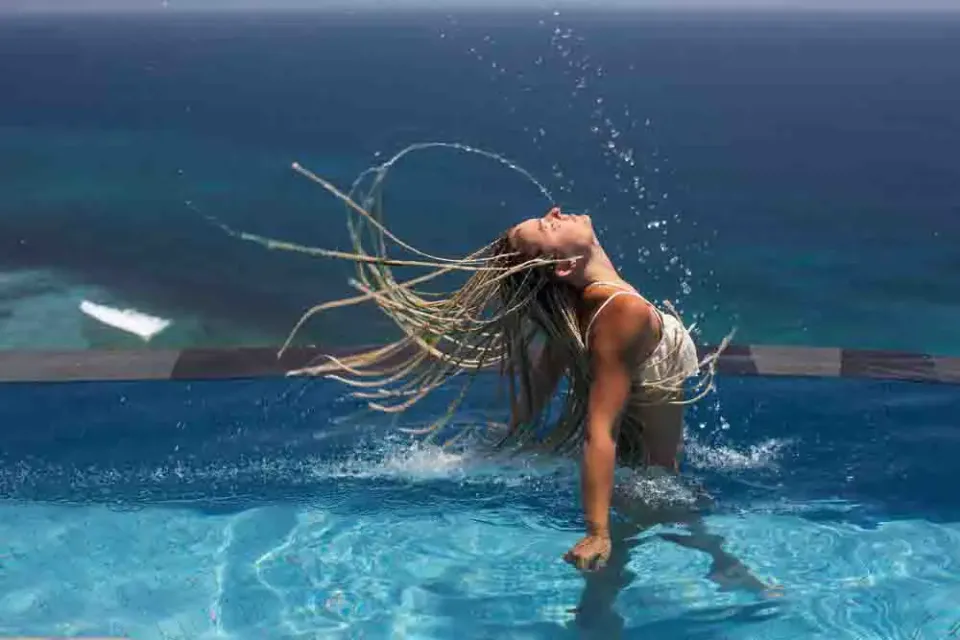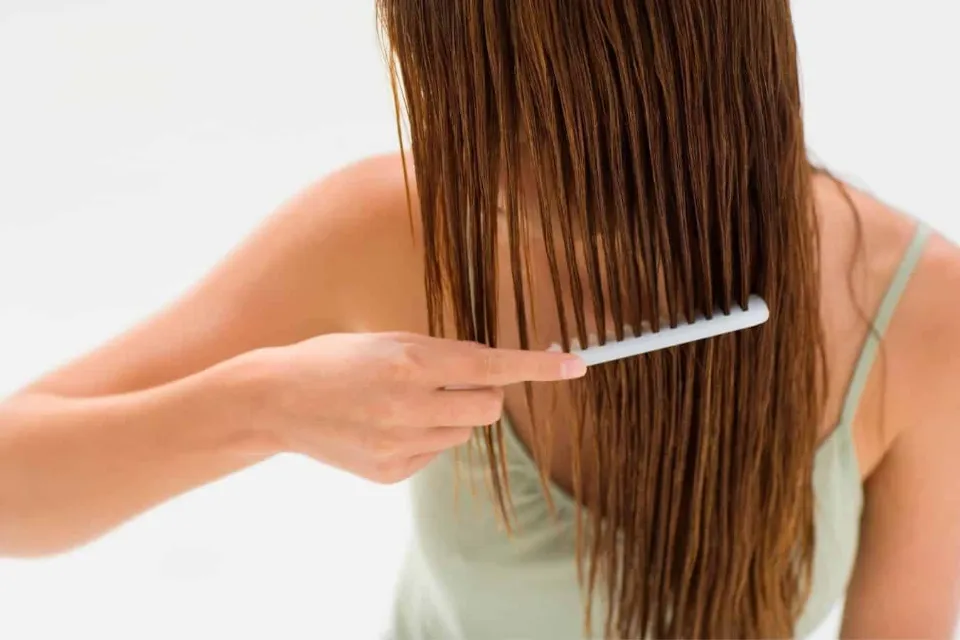If you are planning to go swimming, you may wonder can you swim with box braids.
You can get your braids wet in the shower, pool, and when it’s raining. To prevent fungus growth, hair damage, frizz, and unraveling, we do advise taking a few precautions with your braids.
Learn more about the dangers of getting your braids wet by reading on.
Can You Swim With Box Braids?
The ability to swim with box braids is one of their best features. They will keep your natural hair in place when installed properly because they enclose it inside. What’s more, box braids won’t likely get frizzy after coming in contact with the water (again, if they were installed correctly).
So, you can usually wear box braids and swim without any issues. One of the main reasons women wear braids during swim season, especially if they dislike donning a swim cap, is for this reason.
Knotless box braids are more likely to get frizzy when wet, and that’s because more of your natural hair is exposed near the roots with this method. Although there may not be much of a difference, there is a higher chance of frizziness.
Read More:
Risks of Getting Your Braids Wet

It can’t be that bad to get your braids wet, can it? Allowing your braids to become waterlogged entails some serious risks, which we’ll explain in more detail below.
Fungal Growth
Mold and mildew are perfect candidates for breeding in moist, warm, enclosed spaces. This means that mold growth is possible in wet braids that are improperly dried.
An unpleasant smell coming from the braids is the first indication of fungal growth. It’s also difficult to remove mold and mildew once it starts to grow in your braids.
Your braids are more likely to grow fungus if they are wet for a longer period of time. So, it’s crucial to completely dry your braids as soon as possible and as thoroughly as you can.
We’ll outline how to correctly dry your braids in more detail later on in this article. It is always easier to prevent mold growth than it is to remedy it.
Hair Damage
According to research, hair is weaker when it’s wet, making braids that are wet more prone to breaking. When you have heavy braids, your roots are under a lot of stress from the weight of the braids, which increases the likelihood that they will break (e.g., hairline).
When using weave versus using your natural hair to make braids, there are different risks associated with getting box braids wet.
Also, swimming in chlorinated water can cause your hair to dry out and become weaker, leading to brittleness and breakage in some cases.
Related Reading: Do Box Braids Damage Hair?
Frizz and Unraveling
Frizz is another risk associated with wet braids. Your natural hair swells and expands when it is in the water, and it frequently looks much frizzier after drying. Some fashions can be destroyed with just one swim.
Box braids and cornrows won’t frizz up as much as a single French braid or crown braid would. It all depends on how much tension is used when installing the braids; the less tension used during installation, the more frizzy the hair will be after coming into contact with water.
Unraveling is yet another problem you might experience. If your braids are not properly fixed, water will cause them to unravel.
Read More: How Long Do Box Braids Last?
How to Swim With Box Braids?
Though you can swim with box braids, there’s a right way and a wrong way to do it. We’ll explain how to do it correctly in this section. You can maintain the sleekness of your braids and maintain the health of your hair in this way.
Recommend Rinsing Hair to Wash Chlorine Away
You should take a few precautions to mitigate the effects of the chemical when swimming in chlorinated water. Rinse your hair with clean water after you get out of the pool.
Whether you’ve taken a deep dive or have only received a few splashes, this step is necessary.
Your hair may become dry, change in color, become brittle, and develop more split ends once chlorine has entered your braids.
If you have time, you could also wet your hair before getting into the pool. Your natural hair won’t be able to absorb as much pool chlorine if it has been thoroughly washed. But afterward, you still need to rinse your hair.
Washing Braids After Swimming
If you’ll be swimming multiple times over the course of a week or so, we recommend rinsing your hair may be more convenient and less drying.
However, washing your braids is the best thing to do after getting out of the pool if you will only be swimming once or twice during your vacation or event. Shampoo has a greater ability than plain water to clean contaminants out of your hair.
Scrub and Moisturize Your Scalp
We’ve focused a lot on your hair thus far, but your scalp also needs TLC after a swim. That’s because swimming in a chlorinated pool may make your scalp feel a little itchy or irritated.
The chlorine can be removed from your scalp by rinsing it thoroughly and lightly brushing it. We’d like to emphasize “lightly” because if you scrub your scalp too hard, you can disturb your roots and create frizz or even superficial cuts on your scalp.
Following a thorough cleaning, you should moisturize your scalp with your preferred calming oil, such as vitamin E oil, coconut oil, jojoba oil, or olive oil. You can choose the oil that you use.
Dry Your Braids Thoroughly
Nobody wants their braids to be mildewed or moldy, but that doesn’t stop unaware women from having fungi grow in their braids after getting them wet.
Mold and mildew can start to grow in just one or two days. Fortunately, it can be avoided with relatively little effort.
Here are the steps you need to take to dry your braids after swimming:
- Allow them to freely air dry. After you get out of the pool, gently squeeze out the excess water and let your braids dry the rest of the way in the open air. Don’t wear any hats or put your hair up in a ponytail. Some of the moisture may become trapped if you do this.
- Use a hooded dryer. A hooded dryer is the quickest and most effective way to dry your box braids. After exiting the pool, stack your braids atop your head and place them under the dryer to dry completely. On average, it takes about 30 minutes to dry braids this way, but if your braids are super thick or long, it could take much longer.
- Wait until your braids are completely dry before styling them. Many women make the error of styling their braids while they are drying, such as by placing them in space buns, high ponytails, low ponytails, etc.). All of these hairstyles cause mold and mildew to begin growing faster because they trap moisture in your braids.
For more information, please read our guide on How to Care for Box Braids.
Conclusion: Can You Swim With Box Braids
We hope that the information in this article enables you to wear braids (micro braids, box braids, braid extensions, etc.) and swim to your heart’s content, knowing exactly what to do to preserve your hairstyle and your hair’s health.
Now you can wash your braids or take a dip in the pool without obsessing over what could happen. You are aware of the hazards associated with getting your braids wet as well as how to avoid them.
Read More: How to Take Care of Knotless Braids?
FAQs
Can You Get Braids Wet in the Pool?
The pool is a good place to get your braids wet.
Can You Swim With Goddess Braids?
Yes, you can swim with goddess braids or get boho braids wet.
Which Braids Are Best for Swimming?
Double French Braids.




